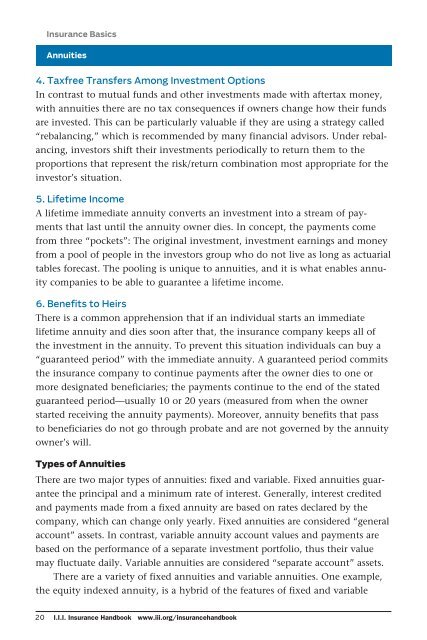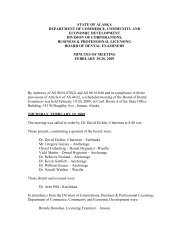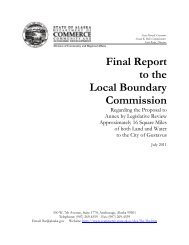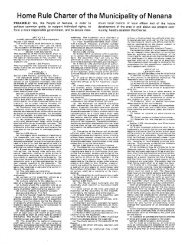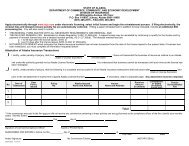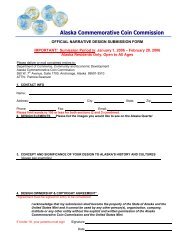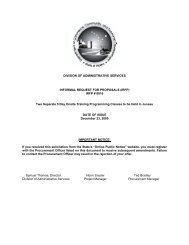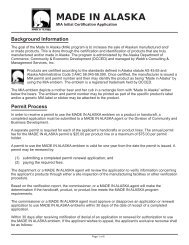Insurance Handbook - Alaska Department of Community and ...
Insurance Handbook - Alaska Department of Community and ...
Insurance Handbook - Alaska Department of Community and ...
You also want an ePaper? Increase the reach of your titles
YUMPU automatically turns print PDFs into web optimized ePapers that Google loves.
<strong>Insurance</strong> Basics<br />
Annuities<br />
4. Taxfree Transfers Among Investment Options<br />
In contrast to mutual funds <strong>and</strong> other investments made with aftertax money,<br />
with annuities there are no tax consequences if owners change how their funds<br />
are invested. This can be particularly valuable if they are using a strategy called<br />
“rebalancing,” which is recommended by many financial advisors. Under rebalancing,<br />
investors shift their investments periodically to return them to the<br />
proportions that represent the risk/return combination most appropriate for the<br />
investor’s situation.<br />
5. Lifetime Income<br />
A lifetime immediate annuity converts an investment into a stream <strong>of</strong> payments<br />
that last until the annuity owner dies. In concept, the payments come<br />
from three “pockets”: The original investment, investment earnings <strong>and</strong> money<br />
from a pool <strong>of</strong> people in the investors group who do not live as long as actuarial<br />
tables forecast. The pooling is unique to annuities, <strong>and</strong> it is what enables annuity<br />
companies to be able to guarantee a lifetime income.<br />
6. Benefits to Heirs<br />
There is a common apprehension that if an individual starts an immediate<br />
lifetime annuity <strong>and</strong> dies soon after that, the insurance company keeps all <strong>of</strong><br />
the investment in the annuity. To prevent this situation individuals can buy a<br />
“guaranteed period” with the immediate annuity. A guaranteed period commits<br />
the insurance company to continue payments after the owner dies to one or<br />
more designated beneficiaries; the payments continue to the end <strong>of</strong> the stated<br />
guaranteed period—usually 10 or 20 years (measured from when the owner<br />
started receiving the annuity payments). Moreover, annuity benefits that pass<br />
to beneficiaries do not go through probate <strong>and</strong> are not governed by the annuity<br />
owner’s will.<br />
Types <strong>of</strong> Annuities<br />
There are two major types <strong>of</strong> annuities: fixed <strong>and</strong> variable. Fixed annuities guarantee<br />
the principal <strong>and</strong> a minimum rate <strong>of</strong> interest. Generally, interest credited<br />
<strong>and</strong> payments made from a fixed annuity are based on rates declared by the<br />
company, which can change only yearly. Fixed annuities are considered “general<br />
account” assets. In contrast, variable annuity account values <strong>and</strong> payments are<br />
based on the performance <strong>of</strong> a separate investment portfolio, thus their value<br />
may fluctuate daily. Variable annuities are considered “separate account” assets.<br />
There are a variety <strong>of</strong> fixed annuities <strong>and</strong> variable annuities. One example,<br />
the equity indexed annuity, is a hybrid <strong>of</strong> the features <strong>of</strong> fixed <strong>and</strong> variable<br />
20 I.I.I. <strong>Insurance</strong> <strong>H<strong>and</strong>book</strong> www.iii.org/insuranceh<strong>and</strong>book


